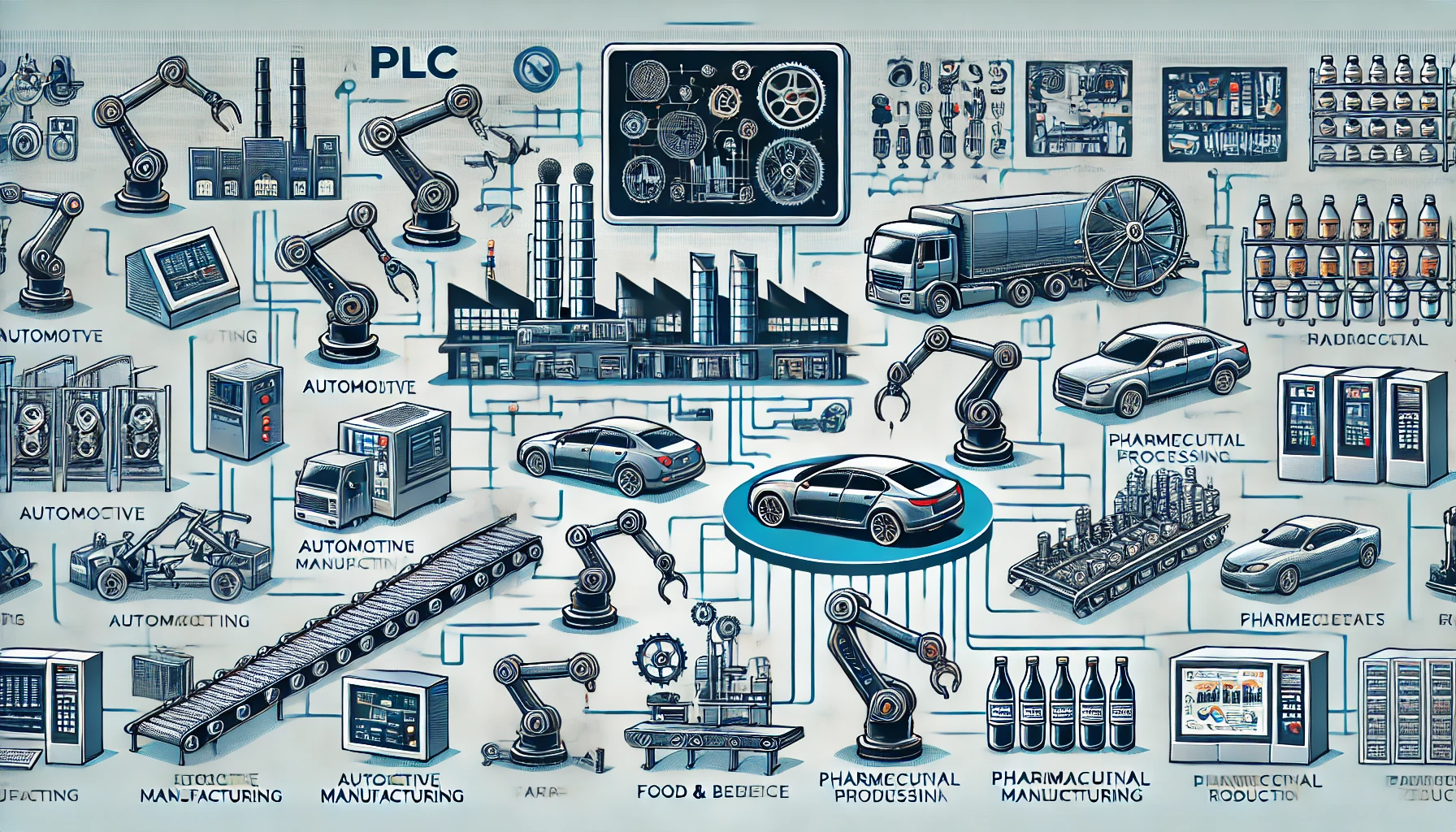PLC Applications in Manufacturing and Production Lines

Programmable Logic Controllers (PLCs) play a critical role in modern manufacturing and production lines by automating processes, enhancing efficiency, and ensuring high-quality production. These industrial controllers provide precise, real-time control over machines and processes, reducing errors, optimizing operations, and increasing productivity.
1. Role of PLCs in Manufacturing and Production
A. Automating Repetitive Tasks
One of the primary uses of PLCs in manufacturing is automating repetitive and labor-intensive tasks, such as:
✔ Assembly line operations – Ensuring seamless product assembly with minimal human intervention.
✔ Material handling – Controlling conveyor belts, robotic arms, and automated guided vehicles (AGVs).
✔ Machine operations – Managing industrial machines like presses, welders, and injection molding machines.
✔ Packaging and labeling – Ensuring accurate and efficient product packaging.
📌 Example:
In an automotive manufacturing plant, PLCs control robotic arms that assemble car parts, improving speed, accuracy, and consistency.
B. Real-Time Process Control
PLCs continuously monitor and adjust temperature, pressure, speed, and other critical parameters in production.
✅ Applications:
✔ Plastic molding – Regulating temperature and injection timing for uniform product quality.
✔ Metal processing – Controlling welding power, forging pressure, and cutting speed.
✔ Chemical production – Managing the mixing and reaction process for consistent output.
📌 Example:
In a food processing plant, PLCs maintain precise temperatures in ovens to ensure baked goods meet quality and safety standards.
C. Quality Control and Inspection
PLCs integrate with vision systems and sensors to automatically detect defects, incorrect dimensions, or missing components.
✅ How PLCs Improve Quality Control:
✔ Monitor sensor data in real-time (e.g., weight, dimensions, surface defects).
✔ Reject defective products using actuators, preventing faulty items from reaching customers.
✔ Log data for analysis, improving production efficiency and defect prevention.
📌 Example:
In electronics manufacturing, PLCs work with cameras to inspect circuit boards and reject faulty components automatically.
D. Material Handling and Logistics
Efficient material handling is essential in supply chain and warehouse automation.
✅ PLCs Control:
✔ Conveyor belts – Regulating product movement between workstations.
✔ Automated Guided Vehicles (AGVs) – Managing robotic transport of raw materials.
✔ Inventory systems – Controlling sorting and storage of products.
📌 Example:
A warehouse uses PLC-controlled AGVs to transport products from storage to shipping stations, improving efficiency and accuracy.
2. Key Benefits of PLCs in Manufacturing
✅ Increased Efficiency – Automating manual processes speeds up production and reduces downtime.
✅ Improved Product Quality – Ensuring consistency, accuracy, and defect reduction.
✅ Enhanced Safety – Monitoring hazardous processes and preventing unsafe machine operations.
✅ Cost Reduction – Minimizing labor costs, waste, and maintenance expenses.
✅ Scalability – Easy to modify and expand for future production needs.
📌 Example:
A bottling plant uses PLCs to control filling stations, ensuring each bottle gets the exact volume, reducing waste and improving quality.
3. Real-World Examples of PLC Applications
A. Automotive Manufacturing
PLCs control robotic welding arms, paint booths, and engine assembly lines.
✅ Key Benefits:
✔ Reduces defects in vehicle assembly.
✔ Increases production speed and efficiency.
✔ Ensures precise welding and painting.
📌 Example:
At Toyota, PLCs coordinate robotic welders, ensuring every car body is assembled with precision and uniformity.
B. Pharmaceutical Production
PLCs regulate temperature, humidity, and ingredient mixing in medicine production.
✅ Key Benefits:
✔ Ensures strict compliance with FDA and GMP regulations.
✔ Automates batch processing with consistent quality.
✔ Prevents cross-contamination with real-time monitoring.
📌 Example:
At Pfizer, PLCs control vaccine production lines, ensuring precise ingredient mixing for consistent dosages.
C. Food and Beverage Industry
PLCs monitor, control, and automate food processing equipment, ensuring hygiene and consistency.
✅ Key Benefits:
✔ Maintains exact cooking temperatures and mixing times.
✔ Automates bottling, capping, and labeling.
✔ Ensures sanitation by monitoring Clean-in-Place (CIP) systems.
📌 Example:
A dairy plant uses PLCs to regulate milk pasteurization, ensuring safety and compliance with health regulations.
D. Textile Manufacturing
PLCs manage dyeing machines, spinning mills, and fabric cutting.
✅ Key Benefits:
✔ Automates precise cutting and stitching.
✔ Reduces fabric waste with optimized processes.
✔ Enhances color consistency in dyeing machines.
📌 Example:
A textile mill uses PLC-controlled dyeing machines to achieve uniform fabric colors, reducing human errors.
4. Future Trends in PLCs for Manufacturing
✅ Industry 4.0 Integration – Smart PLCs connect to IoT, AI, and cloud systems for better monitoring.
✅ Wireless and Remote Access – Engineers can control PLCs from mobile devices.
✅ Energy-Efficient Automation – PLCs optimize power consumption, reducing costs.
✅ AI-Driven Predictive Maintenance – Machine learning analyzes sensor data to predict failures.
📌 Example:
A smart factory uses AI-powered PLCs to analyze machine vibration patterns, predicting failures before they occur.
PLCs have transformed manufacturing and production lines by automating processes, improving quality, and reducing costs. Their ability to control, monitor, and optimize industrial operations makes them indispensable in modern automation.
✅ Key Takeaways:
✔ PLCs automate assembly lines, material handling, and quality control.
✔ They improve efficiency, reduce costs, and enhance product consistency.
✔ Real-world applications include automotive, pharmaceuticals, food processing, and textiles.
✔ The future of PLCs lies in IoT, AI, and smart manufacturing.